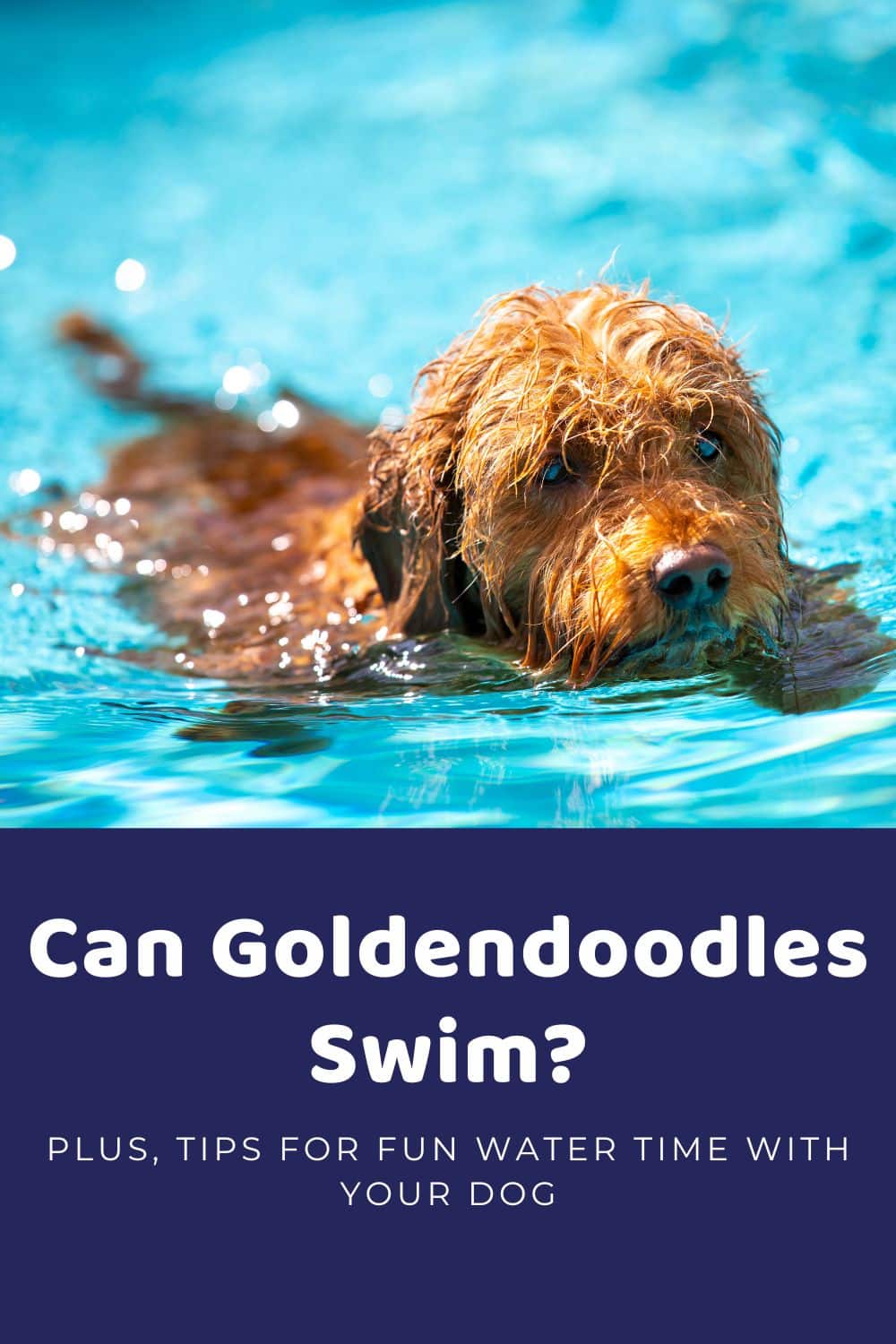Is there anything more rewarding than taking your pup out for the day and seeing them have a fantastic time happily running all over the place? We don’t think so. The benefits of bringing your pet along on a family day out are numerous; they get much-needed exercise, you get to enjoy spending time with them, etc., etc. When the weather is good, you might choose to spend time out by the water. Swimming is an enjoyable way to keep cool when temperatures soar. However, you might be wondering if it’s worth taking your pet along. While some dogs love swimming, others are more reluctant to give it a go. Can Goldendoodles swim and where do they sit with this? Let’s take a look.
Table of Contents
- Do Goldendoodles Like the Water?
- Are Goldendoodles Good Swimmers?
- What About Those Ears?
- How to Introduce Your Goldendoodle to the Water
- Swimming at the Beach vs. the Pool
- Are Salt and Chlorine Bad for Dogs?
- Frequently Asked Questions About Goldendoodles Swimming
- Can Goldendoodles Swim: Conclusion
Do Goldendoodles Like the Water?
In understanding how Goldendoodles feel about water, it’s good to know about their two parent pups. Well, you’ll be delighted to hear that Golden Retrievers and Poodles, both bred as duck retrievers, have a strong affinity for water. The Poodle, in particular, is even categorized as a water dog. Their name derives from the German word pudelin, meaning to splash about. Needless to say, they are not just comfortable spending time in water but are actually adapted to doing so. (We’ll talk a little more about that in just a minute).
So, with these two breeds in the mix, chances are your Goldie will be a BIG fan of water. That being said, every dog is one of a kind. You might end up with one not quite as ecstatic about swimming. Sometimes with rescue dogs, a traumatic experience lurks in their history. Otherwise, they might just be a little more on the timid side. Either way, most pups can be taught to love the water with just a little time and patience.
Are Goldendoodles Good Swimmers?
The idea that all dogs are natural-born swimmers is a myth. The truth is, much like us, this is something they need to learn. That being said, some breeds take to it much faster than others. As covered above, the two Goldendoodle parent breeds both have a water-logged history, meaning they should, at the very least, enjoy spending time in it, but how well do they cope with swimming?
The answer is… pretty well. Both the Golden Retriever and the Poodle have certain adaptations that make them excellent water dogs:
- The Retriever has a thick double coat that keeps them warm in icy depths and partially webbed feet that help them move more easily through the water.
- The Poodle has fully webbed feet and hair that protects their vital organs without weighing them down, making them quick and efficient swimmers.
Chance’s are your Goldendoodle will inherit some of these swimming adaptations, so with a bit of practice, they will be able to manage pretty well.
What About Those Ears?
One of the biggest issues with water when it comes to Doods of every variety are those Poodle floppy ears of theirs. While adding to that super cute teddy-bear appearance that makes them so irresistible, they are a menace when it comes to nasty ear infections.
The problem is that the external flap designed to keep things out, coupled with a Poodle-like narrow ear canal filled with curly hair, is all-too-good at keeping water in. This creates the kind of moist, warm environment that most harmful types of fungi and bacteria love.
The good news is, keeping your pup’s ears clean and infection-free doesn’t need to be a big deal. Many excellent ear-cleaning products reduce dirt buildup and release trapped water. These are all simple to use and cost-effective too.
How to Introduce Your Goldendoodle to the Water
Okay, so we’ve established that your Goldie will likely enjoy swimming and take to it pretty well. However, that doesn’t mean that they will necessarily jump right in. Most dogs are cautious of water at first if they haven’t much experience with it. This is completely normal. It comes with new sights, sounds, smells, and all that…
Some owners think the best way to introduce their pal to water is to dump them right in the deep end or hold them in the water while they get used to it. Neither of these is likely to work all that well. In fact, they could turn your dog right off before you’ve even begun. Baby steps are how you win this particular race:
Tip 1) Start with Shallow Water
A little puddle, stream, or paddling pool will seem far less overwhelming to your dog than a massive expanse of water. If you can find something that barely covers their paws, then this is a good place to begin. Encourage your pooch to step in with you, or if your pet enjoys fetching toys (they are retriever dogs through and through, after all), this can be a good way to begin introducing them to swimming.
Tip 2) Choose a Quiet Location
Find a spot without too many distractions for your first few “water lessons” Let your pup play and explore near the water’s edge and take things at their own pace. A pond or a beach without waves is better for this stage, as waves can be pretty unnerving. If you and your family get into the water, you are more likely to tempt them with plenty of fuss and praise.
Tip 3) Transition to Deeper Water
Slow and steady rip the trick. Once your Goldie is confidently stepping in and out of the shallows, you can start to take things further. Again, this should be done at your dog’s pace. If you have any friends with water-loving pups, you might be able to speed things up a little. Goldendoodles are incredibly smart and will learn just as well (if not better) from other dogs. Chances are they will be playing with them in the water in no time at all.
Tip 4) Water Safety
When your pet finally hits their stride, it can be great. There will be no stopping them after that. However, while your pet may seem fully confident and capable in the water, you need to ensure they stay safe:
Firstly, pick spots with clear water access points that your dog can manage independently. They may be more than happy to jump in but struggle to climb a steep bank to get out, and you’ll be going in after them – not quite as fun as it sounds!
Check for hazards, including trash in the water, unfriendly wildlife, discarded fishing gear, or signs that the water is unclean or contaminated. Make sure there isn’t a strong rip current or overly large waves. A good rule of thumb is, if you wouldn’t feel comfortable going into the water or allowing your kids to, you shouldn’t let your dog either.
Be sure to supervise your dog in the water at all times. Even the strongest of canine swimmers can get into trouble. Puppies and older dogs will be less able to regulate their exercise needs, so you might need to call your pet out if you can see they are getting tired. Be mindful of extreme temperatures, which could affect your pup in different ways – hypothermia, heat exhaustion, etc.
If your senior Goldie still enjoys water time but can’t quite keep up like they used to, you might consider using a doggy flotation device. These are also great if you want to take your pup out in deeper water, such as in a boat, kayak, or stand-up paddle board. They also double up as a harness to stop them from jumping overboard at an inopportune moment.
Swimming at the Beach vs. the Pool
Most dogs adore the beach – all that lovely space to run, sand to dig in, and surf to run in and out of. Water access is usually pretty good, and most hazards are easy to spot. However, things can quickly get tricky if your pup is not up to snuff with coming when called, especially if there are plenty of other people on the beach not looking to be covered with sand and loving canine kisses. Other beach-related issues include tidal flow, rubbish, and underwater debris and rocks, which could damage your baby’s delicate paw pads.
Pools, on the other hand, are much safer knowing precisely what hazards to expect, and you won’t be disturbing other people. However, there are often access issues, and most pools are too deep for dogs to stand, even in the shallow end. This is not great if your pal tires easily. Allowing your dog into your pool will also make its maintenance a lot more complicated.
Are Salt and Chlorine Bad for Dogs?
While salt and chlorine aren’t necessarily bad for dogs, you’ll want to ensure your pet doesn’t drink it, and it’s also a good idea to give them a thorough rinse down after swimming. Both salt and chlorine can dry a dog’s skin, causing itching and irritation. However, you won’t need to bathe your pup with shampoo whenever they come out of the water. Just make sure to get the salt and chlorine out with fresh water.
Frequently Asked Questions About Goldendoodles Swimming
While Goldendoodles can love water, not every one of them will. Each pup has its own personality and likes and dislikes. Some Goldies may never learn to love water, while others may be especially nervous around it because of previous bad experiences. Give your pet the time and opportunity to swim, and encourage, but don’t force it.
Your Goldendoodle should have the right instincts for swimming from their water-loving parent dogs, but they will need time to get used to it. That’s why it’s good to start your pup off in the shallows and let them get a little deeper when they are ready while still being in a position where they can touch the bottom as and when needed.
Can Goldendoodles Swim: Conclusion
Swimming with your Goldendoodle can be a fun experience for outdoor-loving families. If you’re excited about introducing your new puppy to the water, just take care not to rush them. Take the time to do it slowly and gradually, enabling them to grow in confidence, and you’ll quickly find that getting your Goldendoodle out of the water becomes the biggest challenge of all!










